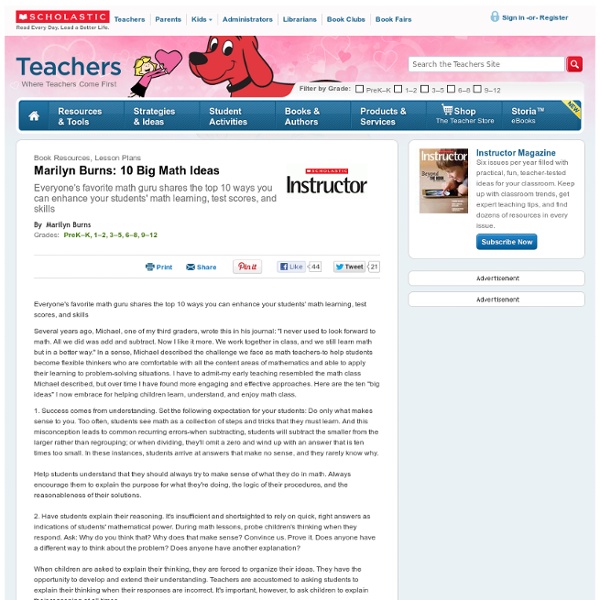



Activities - The Geometer's Sketchpad Resource Center Back to the Introduction On this page you can read about activities, download individual sketches, or download the entire collection of sketches, handouts and Teacher Notes. You are free to photocopy these activities for use in your own classroom. You are also free to make changes to the sketches themselves to suit your own needs; but please be sure to save them under different filenames so you don't confuse them with the original sketches. These sketches require Sketchpad 4.0 or later. Living Math! The Myth of 'I'm Bad at Math' - Miles Kimball & Noah Smith “I’m just not a math person.” We hear it all the time. And we’ve had enough. Is math ability genetic? How do we know this? Different kids with different levels of preparation come into a math class. Thus, people’s belief that math ability can’t change becomes a self-fulfilling prophecy. The idea that math ability is mostly genetic is one dark facet of a larger fallacy that intelligence is mostly genetic. A body of research on conceptions of ability has shown two orientations toward ability. The “entity orientation” that says “You are smart or not, end of story,” leads to bad outcomes—a result that has been confirmed by many other studies. You have a certain amount of intelligence, and you really can’t do much to change it. They found that students who agreed that “You can always greatly change how intelligent you are” got higher grades. The results? For almost everyone, believing that you were born dumb—and are doomed to stay that way—is believing a lie. So why do we focus on math? 1.
Foldables & Study Guides Lose a foldable? All foldables & study guides that we have made in class are available below. If you need help filling in the blanks, please see the completed foldable or study guide in the classroom. Remember, many of these files were copied back-to-back, so a two-page file is the front and back of the foldable. 6th Grade Adding and Subtracting Fractions and Mixed Numbers (PDF 11 KB)Four-door foldable for operations with fractions. 6th Grade Multiplying and Dividing Fractions and Mixed Numbers (PDF 12 KB)Four-door foldable for operations with fractions. 6th Grade Decimals Foldable (PDF 43 KB)Four-door foldable for decimal operations 6th Grade Ratio, Rates, and Proportions (PDF 46 KB)This foldable gives definitions and examples of ratios, rates, and proportions. 6th Grade Proportions (PDF 32 KB)This foldable shows the steps needed to solve a proportion. 6th Grade Percents (PDF 70 KB)This tabbed-book is a great overview of percents. Mrs.
NC Math Common Core - home Home page Eggs-ploring Math With Jellybeans Subjects Arts & Humanities --Visual Arts Mathematics --Applied Math --Arithmetic --Probability --Statistics Grade [facebookbadge] Brief Description Jellybean math activities teach estimation, place value, graphing, rounding, and probability. Objectives Students will follow directions. Keywords egg, jellybean, math, estimation, place value, graphing, rounding, computation, probability Materials Needed[shopmaterials] See the Preparation section of each of the five activities below for specific activity requirements. jellybeans math paper and pencils bowl plastic sandwich bags small paper cups blindfold dice Lesson Plan Jellybeans -- or jelly eggs -- can be used to teach and/or reinforce such math skills as addition, place value, probability, graphing, and estimation. Note: Some students might have allergies to jellybeans or physical conditions that prohibit them from eating jellybeans. Activity 1: Estimation, place value, graphing, rounding, and computation. Estimation. Assessment
Learning Math Through Telling Stories Tuesday, July 3, 2012 From the University of Western Ontario: “Education professor George Gadanidis is attempting to revolutionize the way math is taught in elementary classrooms by applying principles from the world of art. Gadanidis and his research team developed a framework for approaching typical math problems in an atypical way—lessons are tackled through storytelling, drama and even music. By way of example, he offered a different approach to teaching elementary students infinity, a concept not taught until high school. I love this—borrowing the richness and unexpectedness of art to communicate the wonder of math to kids—and giving them a good story to tell about it.
Welcome to the Mathematics Assessment Project “And I’m calling on our nation’s governors and state education chiefs to develop standards and assessments that don’t simply measure whether students can fill in a bubble on a test, but whether they possess 21st Century skills like problem solving and critical thinking and entrepreneurship and creativity.” President Obama, 1 March 2009. New lessons: We've been steadily adding new 'Classroom Challenge' lessons for grades 6-8 over the last few months, and in a few weeks all of the planned 20 lessons for each grade from 6 to 10 will be available. New – TRU Math: Teaching for Robust Understanding of Mathematics is a suite of tools for professional develompent and research - the alpha versions of these documents are available here. The project is working to design and develop well-engineered assessment tools to support US schools in implementing the Products Classroom Challenges: lessons for formative assessment, some focused on developing math concepts, others on non-routine problem solving.